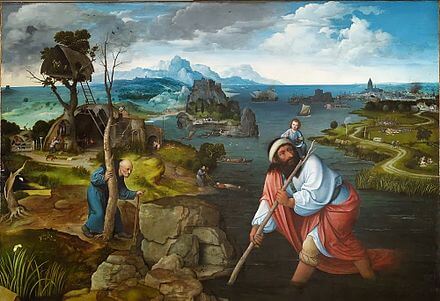Art and sea
- 17/05/2021
In ancient times, and until the XVth century, at the best, the sea accompanied the representation of a deity, Poseidon for the Greeks and Neptune for the Romans.
At worst, it is simply a decorative support carrying ships, galleys, or canoes.
For example, in Egyptian painting, the surface of the water is simply represented by a series of parallel wavy lines and appears only in a narrative context (of petroglyphs, vases, coins, mosaics…).
Until the end of the Middle Age, artists definitely paint more often water as a natural element as the sea itself, insufficient to start an art movement that nevertheless emerge in the early 16th century.


JOACHIM PATINIER, SEA’S FATHER
While the old intellectual and artistic Europe is still under the powerful influence of the Church, a liberal flavor begins to bloom in Germany and in the Netherlands where painters are released gradually from religious subjects.
The first "marines" paintings are mostly panoramic landscapes seen from above.
This new conception of the representation of the sea is blown by the Flemish painter, Joachim Patinier (1483-1524), and corresponds to the new Renaissance cartography that develops a “crow fly” overview of territories.
At first, the Dutch painters will clearly dominate the marine painting.
Originated from an essentially maritime country, also with a flourishing maritime trade, they paint as well as the peace and quiet of estuaries, harbors and canals as well as water warrior’s events between Holland and England, the other major trading power.
WAR AND SEA
Following the decline of the Netherlands, the Batavian painters are migrating to England and are introducing a new artistic movement.
So are born so many British artists working in the marine style.
In the meanwhile, in the XVIIIth century, all the major European powers had Marines of war and trade extremely active, which inevitably led to many wars.
As few people, especially the ruling nobility, are traveling by sea, they have no idea of what may resemble those wars, so then an important pictorial need emerges.
To this are added special requests from the captains, admirals and other boat owners wishing to contemplate their ships or actions: the naval portraitist business is at its peak.
The British Navy overlooking the water and painters depicting the victories, until the 20th century, logically, marine painting was predominated by the English production.
Pictorially, the style evolves and differs from the Dutch influence.
The horizon has taken its place for a long time, because the point of view is now located at the bridge of a building, probably because more and more artists are boarded.
IN THE XXTH CENTURY: EVERYTHING IS ALLOWED
From the late XIXth century to the early XXth, peace being restored, the audience will shift from marine subjects.
However, every major port has marine portraitists who take advantage of the arrival of steamboats and fishing scenes to produce artworks without actually following the evolution of the painting of this century.
Remaining mainly descriptive, the marine painting will be upset by the arrival of photography that will bring artists to paint subjects of old times, to imagine historical scenes, against the current trends of the time who demonstrate need to innovate, create and deconstruct especially with the arrival of abstract art.

Marine painting from the late XXth saw all the trends at the same times:
the thoroughness of Chancellor, the light of Blossom, the humanism of Castelli, the narration of Hunt, the esotericism of Alaux, the, clarity of Marin-Marie, the joy of Brenet, the irony of Berthier, the classicism of Myers, the surrealism of Lecocq...
NATALIA VILLANUEVA
Natalia Villanueva, grew up on the Catalan coast and deeply absorbed the marine atmosphere.
Fascinated by this landscape, she went in search of the seaside in other countries (Morocco, Senegal, Italy, and Spain).
In contact with fishing ports, sailors and solitary lighthouses, she found strength and inspiration for her painting.
Natalia paints imaginary seascapes, inspired by environments in which she has been.
Her work brings the figurative to a purified representation.
She releases the seascape by giving lots of light, contrast and texture to her artworks.
Her approach is to modernize and to revive the tradition of nautical painting.
Natalia uses a marine theme to convey to the viewer the feeling of freedom, strength and the joy of life.
THE NEO-COLLECTOR'S GUIDE
Everything you always wanted to know about the art market but were afraid to ask!
The art market often appears to be a domain reserved for a privileged few...
This is not true: accessible to all, the art market is only waiting for its new collectors.
For those who still have a doubt :
Here are the answers to the questions commonly asked!
What is a work of art?
What is the purpose of art?
What is the purpose of a certificate of authenticity?
What should you look out for when buying a work of art?
















